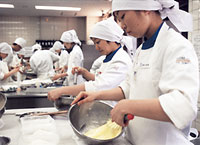|
|
|||||||
|
|
|||||||
|
|||||||
| | Web Japan >>| Trends in Japan >> | Lifestyle >> | "I Want To Be a Craftsman" | |
|
"I WANT TO BE A CRAFTSMAN" Changes in Young People's Attitudes To Work (September 2, 2003) People who make a living by making things with their hands are known as craftspeople. The word carries connotations of grueling apprenticeships and hard physical labor, and for some decades now this has tended to put young people off the trades. Recently, however, the number of youngsters entering the trades has been on the rise, in part because of changes in the younger generation's ideas of what constitutes a good job. This is good news for the traditional industrial arts professions, which have been suffering from a shortage of young people willing to take over the mantle from older practitioners.
A Modern Craftsman's Curriculum Though more young people these days find themselves drawn to skilled labor by the nature of the work, it is hard for a generation that has grown up in times of plenty to shake its anxieties about taking on apprenticeships. This explains why the publishers of Gaten get so many telephone inquiries from readers wondering how long it would take to become a full-fledged craftsperson, whether an apprenticeship would entail a harsh training regimen of the old-school variety, and so on. Those hoping to enter trades historically accessible only via apprenticeships might be relieved to hear that an alternative has emerged, in the form of a new kind of school that cultivates craftsmen within the framework of the modern educational system. One example is the Esperanza Institute of Footwear Design and Technique in Tokyo's Taito Ward, where 36 students per year learn the shoemaking trade in a two-year program following a modern-style curriculum. When it first opened, the academy limited admission to cobblers' apprentices, but in 1993 it opened its doors to the general public, and since then, the number of applicants has skyrocketed. Before enrolling, prospective students are required to observe cobblers at work so that they can see for themselves the hard labor involved in making shoes. Even so, the school reports that it receives two applications for every place available. Another popular trade school is the Tokyo Patisserie School in Tokyo's Shinjuku Ward, which trains confectioners. A day at the institute runs from 8:30 in the morning until 4:30 in the afternoon, and 80% of the packed curriculum consists of hands-on training. During the two-year program, students learn how to make about 550 kinds of cake. The curriculum is tough, but that does not seem to bother the students. In the words of one student, "I've aspired to do this kind of work ever since I was a child, so I don't find it hard to take." The confectionery institute has seen a sharp rise in applications over the past seven years or so. The majority of applicants enter the institute straight from high school, but a substantial number enroll after graduating from college or quitting their jobs to learn the art of making cakes. The standard system of training apprentices in regional industrial arts, such as silk weaving, pottery, and lacquerwork, has also been updated. Under the old apprenticeship system, masters took apprentices into their homes and taught them the trade. As part of this arrangement, apprentices were also expected to help out with housework. But today's young people, having grown up in comfort, are put off by this system, and regional arts and crafts throughout Japan have been suffering an increasingly severe dearth of new talent capable of carrying on their traditions. But now these arts, like the trades, are getting a boost from curriculum-based training. The Tochigi Prefecture Tsumugi Textiles Instruction Center in the city of Oyama trains people in the craft of loom-weaving Yuki Tsumugi silk, a regional specialty. As a condition of their training, students agree to work in the weaving industry within Tochigi Prefecture after completing their course. The prefecture operates many such facilities to train people in traditional local crafts, and the relatively low class fees are attracting young people who aspire to become artisans.
The Appeal of the Craftsman's Life The reality, of course, is that setting out as an independent tradesperson takes much more than just finishing a course of training. But even if some young people may have somewhat unrealistic expectations, there is no doubt that their interest in entering crafts and trades has grown. If the number of places where such enthusiastic youngsters can master and then practice their chosen skills increases, the future of skilled and creative professions in Japan will be very bright indeed. Related Web SitesGaten (Japanese only) Esperanza Institute of Footwear Design and Technique (Japanese only) Tokyo Patisserie School (Japanese only) Copyright (c) 2004 Web Japan. Edited by Japan Echo Inc. based on domestic Japanese news sources. Articles presented here are offered for reference purposes and do not necessarily represent the policy or views of the Japanese Government. |
KEEPING TRADITION ALIVE (February 20, 2003) GRAY IS GOOD (July 4, 2002) UNIVERSITY STUDENTS' VISION OF THEIR FUTURE (December 5, 2001) |
|
|



